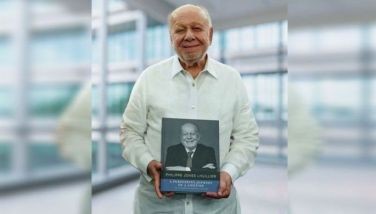PAL sees lower profit due to mounting costs
October 10, 2000 | 12:00am
Rising fuel costs and the steady decline of the peso against the dollar have tolled heavily on flag-carrier Philippine Airlines (PAL) as net profit starting April last year up to end September is expected to be 35 percent lower than projected, it was learned yesterday.
This still has not yet taken into account the expected negative impact which the recent signing of a new air services agreement between the Philippines and Taiwan last Sept. 26 – restoring commercial airlinks between the two countries – will have on PAL.
Because of this, PAL and its creditors said the airline will not meet its target profit of P2.52 billion this year.
In an exclusive interview, PAL president and chief operating officer Avelino Zapanta said that they expect to lose as much as 30 percent of their revenue, or around $200 to $300 million of their annual $800 million total revenue if Taiwan fully utilizes its sixth freedom right under the newly signed air services agreement with the Philippines.
The agreement specifically guarantees sixth freedom rights to Taiwan, allowing its airlines to transport passengers to the US for instance via Taipei or Kaoshiung. In other words, both China Airlines and EVA Air of Taiwan can ferry Filipinos to any point beyond Taiwan.
Zapanta said that PAL’s trans-Pacific flights remain the bread and butter of the flag carrier, accounting for 30 percent of its revenues or between P200 and P300 million. Its Middle East flights, on the one hand, account for another P100 million.
From a projected P1.4 billion net profit by end-September under its rehabilitation plan, PAL expects income to reach only P920 million. As of end-August this year, the airline realized a net profit of P893 million compared to P200 million in the same period last year. In September which is the leanest month in terms of operations, PAL expects to make around P30 to P33 million.
Zapanta said that the rehabilitation plan used as the basis for its income projection an aviation fuel cost of between $15 to $18 per barrel.
"The Securities and Exchange Commission and PAL’s creditors are now reviewing our projection of our net income for a downward adjustment due to the spiralling cost of fuel and of course, the effect of the agreement with Taiwan," Zapanta said.
While the impact of the depreciation of the peso against the dollar on PAL has so far been offset by its substantial foreign exchange revenue, Zapanta expects that this will not be the case in the following months as dollar expense can still go up due to increasing fuel expense. "On the one hand, our dollar revenue may no longer increase," he said.
As to the impact which Taiwan’s exercise of its sixth freedom will have on PAL, Zapanta said everything will depend on the improvement of Taiwan’s own traffic.
He said that starting in 1997 when the Asian crisis adversely affected Taiwanese business traffic, the Taiwanese carriers started eyeing Philippine traffic. "With signs of improvement in the Taiwanese economy, there will be more Taiwanese who will travel, and hopefully, they will accommodate less Filipinos," he said.
"Ambassador Reyes (of the Manila Economic and Cultural Office) has also pleaded to the Taiwanese to exercise self-restraint. But knowing the Taiwanese who will travel, and hopefully, they will accommodate less Filipinos," he said.
Zapanta also expressed hopes that with PAL improving its services, more Filipinos will be patronizing the Philippine flag carrier.
This still has not yet taken into account the expected negative impact which the recent signing of a new air services agreement between the Philippines and Taiwan last Sept. 26 – restoring commercial airlinks between the two countries – will have on PAL.
Because of this, PAL and its creditors said the airline will not meet its target profit of P2.52 billion this year.
In an exclusive interview, PAL president and chief operating officer Avelino Zapanta said that they expect to lose as much as 30 percent of their revenue, or around $200 to $300 million of their annual $800 million total revenue if Taiwan fully utilizes its sixth freedom right under the newly signed air services agreement with the Philippines.
The agreement specifically guarantees sixth freedom rights to Taiwan, allowing its airlines to transport passengers to the US for instance via Taipei or Kaoshiung. In other words, both China Airlines and EVA Air of Taiwan can ferry Filipinos to any point beyond Taiwan.
Zapanta said that PAL’s trans-Pacific flights remain the bread and butter of the flag carrier, accounting for 30 percent of its revenues or between P200 and P300 million. Its Middle East flights, on the one hand, account for another P100 million.
From a projected P1.4 billion net profit by end-September under its rehabilitation plan, PAL expects income to reach only P920 million. As of end-August this year, the airline realized a net profit of P893 million compared to P200 million in the same period last year. In September which is the leanest month in terms of operations, PAL expects to make around P30 to P33 million.
Zapanta said that the rehabilitation plan used as the basis for its income projection an aviation fuel cost of between $15 to $18 per barrel.
"The Securities and Exchange Commission and PAL’s creditors are now reviewing our projection of our net income for a downward adjustment due to the spiralling cost of fuel and of course, the effect of the agreement with Taiwan," Zapanta said.
While the impact of the depreciation of the peso against the dollar on PAL has so far been offset by its substantial foreign exchange revenue, Zapanta expects that this will not be the case in the following months as dollar expense can still go up due to increasing fuel expense. "On the one hand, our dollar revenue may no longer increase," he said.
As to the impact which Taiwan’s exercise of its sixth freedom will have on PAL, Zapanta said everything will depend on the improvement of Taiwan’s own traffic.
He said that starting in 1997 when the Asian crisis adversely affected Taiwanese business traffic, the Taiwanese carriers started eyeing Philippine traffic. "With signs of improvement in the Taiwanese economy, there will be more Taiwanese who will travel, and hopefully, they will accommodate less Filipinos," he said.
"Ambassador Reyes (of the Manila Economic and Cultural Office) has also pleaded to the Taiwanese to exercise self-restraint. But knowing the Taiwanese who will travel, and hopefully, they will accommodate less Filipinos," he said.
Zapanta also expressed hopes that with PAL improving its services, more Filipinos will be patronizing the Philippine flag carrier.
BrandSpace Articles
<
>
- Latest
- Trending
Trending
Latest
Trending
Latest
Recommended
December 1, 2024 - 12:00am
November 29, 2024 - 12:00am



























